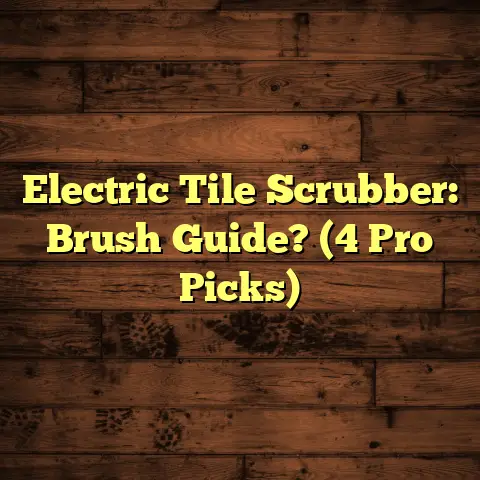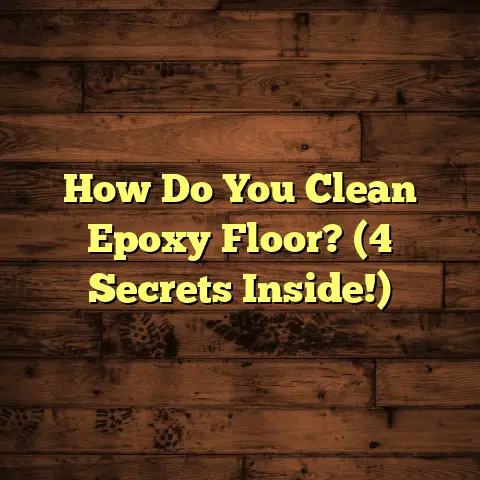Moldy Laminate? Remove it Fast! (3-Step Cure!)
It’s the go-to for so many homeowners.
I get it. As a flooring contractor, I’ve seen it all. It’s affordable, pretty darn durable, and installing it? A breeze compared to some other materials.
But here’s the thing: even this superstar flooring isn’t invincible.
One of the biggest problems I see creeping up? Mold. Yep, that nasty stuff.
It’s not just gross; it can be a real health hazard and wreck your beautiful floors.
Think of it like this: you wouldn’t let a small leak turn into a flood, would you?
Mold is the same. Catch it early, and you’re golden. Ignore it, and you’re looking at a bigger, messier, and more expensive problem.
Mold loves moisture. Whether it’s a leaky pipe, a spill that didn’t get cleaned up properly, or just high humidity, laminate can become a breeding ground.
And trust me, once it takes hold, it can spread fast.
That’s why I’m writing this. I want to give you a clear, no-nonsense guide to tackling mold in your laminate flooring head-on.
We’re going to break it down into a simple, three-step cure.
Think of it as your DIY rescue plan.
Here’s what we’ll cover:
-
Step 1: Identify and Assess the Mold Problem: We’ll figure out how bad the situation is and what you’re dealing with.
-
Step 2: Remove the Moldy Laminate: I’ll walk you through the safe and effective removal process.
-
Step 3: Preventing Future Mold Growth: We’ll talk about how to keep that mold from ever coming back.
Ready to get started? Let’s dive in!
Section 1: Understanding Mold and Its Impact on Laminate Flooring
Okay, let’s get down to the nitty-gritty.
What exactly is mold, and why is it such a pain when it comes to laminate flooring?
Simply put, mold is a type of fungus.
It thrives in damp, dark places. Think of it as nature’s recycler. It breaks down organic matter.
That’s great for the forest floor, but not so great for your living room.
Laminate flooring, while mostly synthetic, often has a wood-based core.
This core can be susceptible to mold growth if it gets wet.
So how does mold even get there in the first place?
Here are some common culprits I see all the time:
-
Water Damage: Leaky pipes, overflowing toilets, even just a spill that wasn’t cleaned up properly. Water seeps into the seams of the laminate and creates the perfect environment for mold.
-
High Humidity Levels: Especially in bathrooms, kitchens, and basements. If the air is constantly damp, mold can start to grow even without a direct water source.
-
Lack of Ventilation: Stagnant air allows moisture to build up. This is especially true under furniture or in corners.
-
Improper Installation: If a moisture barrier wasn’t installed correctly (or at all) beneath the laminate, moisture from the subfloor can wick up and cause problems.
Now, let’s talk about why mold is more than just an eyesore.
The Health Risks
I’m not a doctor, but I’ve seen firsthand how mold can affect people. The health risks are real.
Breathing in mold spores can cause a range of problems, especially for people with allergies, asthma, or weakened immune systems.
Here are some common symptoms:
- Respiratory Issues: Coughing, wheezing, shortness of breath.
- Allergic Reactions: Skin rashes, itchy eyes, runny nose.
- Headaches: Persistent headaches can be a sign of mold exposure.
- Sinus Infections: Mold can irritate the sinuses and lead to infections.
And it’s not just about breathing it in.
Touching mold can also cause skin irritation.
Kids and the elderly are especially vulnerable.
Beyond the health risks, mold can also do some serious damage to your home.
It can weaken the structure of your flooring, rot the subfloor, and even spread to walls and other building materials.
The longer you wait to address a mold problem, the worse (and more expensive) it will get.
Spotting the Signs
So how do you know if you have mold growing under your laminate flooring?
Here are some telltale signs I always look for:
- Discoloration: Look for dark spots, stains, or a general discoloration of the laminate. It might look greenish, blackish, or even whitish.
- Odor: A musty, earthy smell is a classic sign of mold. If you notice this smell, especially in damp areas, investigate further.
- Visible Patches: Sometimes, you can see the mold growing right on the surface of the laminate or along the edges.
- Warping or Buckling: If the laminate is starting to warp or buckle, it could be a sign that moisture is trapped underneath, creating a breeding ground for mold.
Early Detection is Key
I can’t stress this enough: the sooner you detect a mold problem, the easier it will be to fix.
Don’t wait until the problem is widespread.
Regularly inspect your floors, especially in areas prone to moisture.
If you see or smell anything suspicious, take action immediately.
In the next section, we’ll dive into how to assess the extent of the mold problem.
Let’s get to it!
Section 2: Step 1 – Identify and Assess the Mold Problem
Alright, you suspect you might have mold under your laminate.
Don’t panic! The first step is to figure out exactly what you’re dealing with.
Think of yourself as a mold detective.
Your mission: to gather clues and determine the extent of the problem.
Here’s how I approach it when I’m on a job:
1. Visual Inspection
Start with a thorough visual inspection.
Grab a flashlight and get down on your hands and knees.
Look closely at the surface of the laminate, paying particular attention to:
- Edges and Seams: These are the most vulnerable areas, as moisture can easily seep in.
- Corners: Dark, damp corners are mold magnets.
- Areas Near Water Sources: Check around sinks, toilets, showers, and any other plumbing fixtures.
Look for any of the signs I mentioned earlier: discoloration, stains, visible patches of mold, warping, or buckling.
Don’t just look at the surface.
If possible, try to peek under the edges of the laminate.
You might need to use a small tool, like a putty knife, to gently lift the edge.
Be careful not to damage the flooring.
2. The Sniff Test
Trust your nose!
A musty, earthy odor is a strong indicator of mold.
Sniff around the affected area.
Does the smell get stronger in certain spots?
That could be where the mold is most concentrated.
3. Moisture Meter Reading
A moisture meter is your best friend when it comes to detecting hidden moisture.
This tool measures the moisture content of materials.
You can find them at most hardware stores.
Here’s how to use it:
- Calibrate the meter according to the manufacturer’s instructions.
- Place the probes of the meter against the laminate flooring in several different areas, including the areas where you suspect mold.
- Take readings and compare them to the recommended moisture levels for laminate flooring. (Generally, you want to see readings below 12-15%).
If you get high moisture readings, it’s a red flag.
It means there’s moisture trapped under the laminate, creating a perfect environment for mold.
4. Checking the Subfloor
If you suspect a serious mold problem, you might need to pull up a section of the laminate to inspect the subfloor.
This is where things can get a little tricky.
If you’re not comfortable doing this yourself, it’s best to call in a professional.
But if you’re feeling adventurous, here’s how I do it:
- Choose an inconspicuous area, like a corner or under a piece of furniture.
- Use a pry bar to gently lift the laminate planks.
- Be careful not to damage the planks or the subfloor.
- Once you’ve removed a section of the laminate, inspect the subfloor for signs of mold, water damage, or rot.
If the subfloor is moldy, you’ll need to address that as well.
This might involve cleaning, treating, or even replacing the affected areas.
Tools of the Trade
Here’s a list of the tools and materials you’ll need for your mold assessment:
- Flashlight: For those hard-to-see spots.
- Moisture Meter: To measure moisture levels.
- Pry Bar: To gently lift laminate planks.
- Utility Knife: To score the laminate if needed.
- Gloves: To protect your hands.
- Mask: To protect yourself from mold spores. (An N95 respirator is recommended.)
- Eye Protection: Safety glasses or goggles.
- Trash Bags: For disposing of moldy materials.
When to Call a Pro
Sometimes, the mold problem is too big or too complex to handle yourself.
Here are some situations where I always recommend calling in a professional:
- Extensive Mold Growth: If the mold covers a large area or has spread to other parts of your home.
- Structural Damage: If the mold has damaged the subfloor or other structural elements.
- Health Concerns: If you or anyone in your family is experiencing health problems related to mold exposure.
- Unsure How to Proceed: If you’re not comfortable assessing or removing the mold yourself.
A professional mold remediation company will have the expertise, equipment, and training to safely and effectively remove the mold and prevent it from returning.
They can also identify the source of the moisture problem and recommend solutions to prevent future mold growth.
Alright, now that you’ve assessed the mold problem, it’s time to move on to the next step: removing the moldy laminate. Let’s go!
Section 3: Step 2 – Remove the Moldy Laminate
Okay, detective work is done.
You’ve identified the moldy laminate, assessed the damage, and now it’s time for the main event: removal.
This is where things get real.
But don’t worry, I’m going to walk you through it step-by-step.
Safety First!
Before you even think about picking up a pry bar, let’s talk safety.
Mold can be harmful, so it’s important to protect yourself.
Here’s what I always wear when dealing with mold:
- Respirator: An N95 or P100 respirator is essential to protect your lungs from mold spores.
- Gloves: Wear disposable gloves to protect your skin.
- Eye Protection: Safety glasses or goggles will prevent mold spores from getting in your eyes.
- Protective Clothing: Wear old clothes that you can throw away after the job. Long sleeves and pants are a good idea.
Gather Your Tools
Here’s a list of the tools you’ll need for removing the moldy laminate:
- Pry Bar: For lifting the laminate planks.
- Utility Knife: To score the laminate if needed.
- Hammer: To tap the pry bar.
- Chisel: To help lift stubborn planks.
- Trash Bags: Heavy-duty trash bags for disposing of the moldy materials.
- Shop Vacuum: With a HEPA filter to clean up mold spores.
- Spray Bottle: Filled with a mold-killing solution (like bleach and water).
- Scrub Brush: For scrubbing the subfloor.
Step-by-Step Removal Guide
Alright, let’s get to it!
Here’s how I remove moldy laminate flooring:
1. Preparation
- Clear the Area: Remove all furniture, rugs, and other items from the affected area.
- Seal Off the Area: If the mold problem is extensive, you might want to seal off the area with plastic sheeting to prevent mold spores from spreading to other parts of your home.
- Ventilate the Area: Open windows and doors to provide ventilation.
- Put on Your PPE: Respirator, gloves, eye protection, and protective clothing.
2. Removing the Laminate Planks
- Start at the Edge: Begin at the edge of the room, near a wall.
- Use the Pry Bar: Insert the pry bar between the laminate plank and the subfloor.
- Gently Lift: Gently lift the plank, working your way along the edge.
- Use the Hammer (If Needed): If the plank is stubborn, tap the pry bar with a hammer to help loosen it.
- Score the Laminate (If Needed): If the planks are glued down, you might need to score the laminate with a utility knife along the seams to help break the adhesive bond.
- Remove the Planks: Once the plank is loose, carefully remove it and place it in a trash bag.
- Repeat: Repeat the process for each laminate plank, working your way across the affected area.
3. Dealing with Stubborn Planks
Sometimes, you’ll encounter planks that are really stuck.
Here are some tips for dealing with stubborn planks:
- Use a Chisel: A chisel can be helpful for prying up stubborn planks.
- Heat Gun: A heat gun can help soften the adhesive bond. Be careful not to overheat the laminate or the subfloor.
- Patience: Don’t force it! Work slowly and carefully to avoid damaging the subfloor.
4. Cleaning the Subfloor
Once you’ve removed all the laminate planks, it’s time to clean the subfloor.
- Vacuum: Use a shop vacuum with a HEPA filter to vacuum up any loose debris, dust, and mold spores.
- Scrub: Mix a mold-killing solution (like bleach and water) in a spray bottle. Spray the solution onto the subfloor and scrub it with a scrub brush.
- Rinse: Rinse the subfloor with clean water.
- Dry: Allow the subfloor to dry completely before installing new flooring.
5. Disposal
Proper disposal of moldy materials is crucial to prevent the spread of mold spores.
- Bag It Up: Place all the moldy laminate planks and other contaminated materials in heavy-duty trash bags.
- Seal the Bags: Seal the bags tightly to prevent mold spores from escaping.
- Check Local Regulations: Check with your local waste disposal company for any special regulations regarding the disposal of moldy materials.
- Dispose of Properly: Dispose of the bags according to local regulations.
Alternative Removal Methods
The method I just described is for general removal.
But sometimes, you might be dealing with a specific type of mold infestation.
Here are some alternative removal methods:
- Minor Surface Mold: If the mold is only on the surface of the laminate, you might be able to clean it with a mold-killing solution without removing the planks.
- Deep-Rooted Mold: If the mold has penetrated deep into the laminate or the subfloor, you’ll need to remove and replace the affected materials.
Important Considerations
- Don’t Spread the Mold: Be careful not to spread mold spores to other parts of your home during the removal process.
- Work Slowly and Carefully: Take your time and work carefully to avoid damaging the subfloor.
- If in Doubt, Call a Pro: If you’re not comfortable removing the mold yourself, or if the problem is extensive, don’t hesitate to call a professional mold remediation company.
Alright, you’ve successfully removed the moldy laminate!
Give yourself a pat on the back.
But the job’s not done yet.
In the next section, we’ll talk about how to prevent mold from coming back.
Let’s keep going!
Section 4: Step 3 – Preventing Future Mold Growth
Okay, you’ve tackled the mold, removed the affected laminate, and cleaned everything up.
Fantastic! But here’s the million-dollar question: how do you make sure it never comes back?
Prevention is key.
It’s about creating an environment where mold simply can’t thrive.
Here are some strategies I swear by:
1. Control Humidity Levels
Mold loves moisture. Period.
The most effective way to prevent mold growth is to control the humidity levels in your home.
Here’s how:
- Dehumidifiers: Use dehumidifiers in damp areas like basements, bathrooms, and kitchens. Aim for a humidity level between 30-50%.
- Ventilation: Ensure proper ventilation in bathrooms and kitchens. Use exhaust fans when showering or cooking.
- Air Conditioning: Air conditioning can help remove moisture from the air.
- Fix Leaks: Repair any leaks promptly, whether it’s a leaky faucet, a dripping pipe, or a roof leak.
- Proper Drainage: Make sure your home has proper drainage to prevent water from pooling around the foundation.
2. Proper Cleaning and Maintenance
Regular cleaning and maintenance can go a long way in preventing mold growth.
Here are some tips:
- Clean Spills Immediately: Don’t let spills sit on the laminate flooring. Clean them up immediately with a dry cloth.
- Use Recommended Cleaning Solutions: Use cleaning solutions that are specifically designed for laminate flooring. Avoid using excessive water, as this can seep into the seams and create a breeding ground for mold.
- Regular Vacuuming: Vacuum your laminate flooring regularly to remove dust, dirt, and debris.
- Dry Mop: Use a dry mop to clean your laminate flooring regularly.
- Avoid Steam Cleaning: Avoid steam cleaning laminate flooring, as the high heat and moisture can damage the flooring and promote mold growth.
3. Moisture Barriers
When installing laminate flooring, it’s crucial to use a moisture barrier.
This will prevent moisture from the subfloor from wicking up into the laminate.
Here are some tips:
- Use a Quality Moisture Barrier: Choose a high-quality moisture barrier that is specifically designed for laminate flooring.
- Install it Correctly: Follow the manufacturer’s instructions for installing the moisture barrier.
- Overlap the Seams: Overlap the seams of the moisture barrier to create a continuous barrier.
- Seal the Edges: Seal the edges of the moisture barrier with tape to prevent moisture from seeping in.
4. Improve Ventilation
Good ventilation is essential for preventing mold growth.
Here are some tips:
- Open Windows: Open windows regularly to allow fresh air to circulate.
- Use Fans: Use fans to circulate air in damp areas.
- Clear Obstructions: Make sure that vents are not blocked by furniture or other obstructions.
- Improve Airflow: Improve airflow by trimming bushes and trees that are close to your home.
5. Regular Inspections
Regularly inspect your laminate flooring for signs of mold growth.
Pay particular attention to areas that are prone to moisture, such as:
- Edges and Seams
- Corners
- Areas Near Water Sources
If you see or smell anything suspicious, take action immediately.
6. Consider Mold-Resistant Products
When replacing your laminate flooring, consider using mold-resistant products.
These products are designed to inhibit mold growth.
Here are some options:
- Mold-Resistant Laminate: Some laminate flooring products are specifically designed to be mold-resistant.
- Mold-Resistant Underlayment: Use a mold-resistant underlayment to provide an extra layer of protection.
- Mold-Resistant Paint: Use mold-resistant paint on walls and ceilings in areas that are prone to moisture.
7. Address Underlying Issues
Mold growth is often a symptom of an underlying problem.
It’s important to identify and address the root cause of the moisture problem.
This might involve:
- Repairing Leaks: Fixing leaky pipes, roofs, or windows.
- Improving Drainage: Improving drainage around your home.
- Addressing Condensation: Addressing condensation problems by improving insulation or ventilation.
Real Talk: My Personal Experience
I’ve seen it all in my years as a flooring contractor. I remember one house where the homeowners had a persistent mold problem under their laminate in the bathroom.
They tried everything – cleaning, bleach, you name it. But the mold kept coming back.
Turns out, there was a tiny, almost invisible leak in the shower drain.
Every time they showered, a little bit of water would seep under the floor.
It wasn’t much, but it was enough to create a perfect breeding ground for mold.
We had to tear out the entire floor, fix the leak, and install a new, mold-resistant laminate with a proper moisture barrier.
The lesson? Sometimes, it’s the little things that make the biggest difference.
Don’t overlook the obvious, and don’t be afraid to dig deeper to find the root cause of the problem.
By following these strategies, you can create a healthy, mold-free environment in your home.
It’s all about being proactive and taking the necessary steps to prevent moisture from building up.
You’ve got this!
Conclusion
So, there you have it!
The three-step cure for moldy laminate flooring.
We’ve covered a lot of ground, from understanding what mold is and why it’s a problem, to identifying and assessing the damage, to safely removing the moldy laminate, and finally, to preventing future mold growth.
Let’s recap why this is so important.
Mold isn’t just an eyesore.
It’s a health hazard that can affect your respiratory system, trigger allergies, and even weaken your immune system.
And it’s not just about your health.
Mold can also damage your home, weakening the structure of your flooring and potentially spreading to other areas.
That’s why it’s so important to address mold issues quickly and effectively.
The three-step cure I’ve outlined is a simple, yet powerful way to tackle mold in your laminate flooring.
It’s something that most homeowners can do themselves with the right tools, knowledge, and a little bit of elbow grease.
Don’t be intimidated!
Take it one step at a time, and remember that you’re not alone.
If you suspect you have mold in your home, don’t wait!
Take action immediately.
The sooner you address the problem, the easier it will be to fix and the less damage it will cause.
With the right knowledge and tools, you can effectively tackle moldy laminate and ensure a safe, beautiful living environment for you and your family.
You’ve got this!
Now go forth and conquer that mold!





